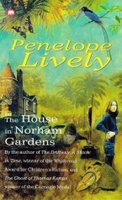
The coincidental occurrence of events that seem related but can't be explained as having some kind of conventional causal relationship is known as synchronicity. I know this because I just looked it up.
Okay, you will all recall, I am sure, that last weekend one of my young relatives and I got going on popular vs. literary fiction. And then, just two days later (Two days is a recurring theme--see my last post.), I stumbled upon a couple of posts on that very subject. (Getting goosebumps?) Nathan Bransford says that in genre (popular/commercial) fiction, the plot tends to be above the surface and that in literary fiction it tends to be below the surface. If I'm understanding his entire post, popular fiction could be said to be about exteriors and literary fiction about interiors.
Now, this same week, I receive a call from my local library (not yours, A Reading Fool) telling me that the copy of The House in Norham Gardens by Penelope Lively that I'd requested through ILL had arrived.
Though I'm interested in Penelope Lively, I only requested this book because Michelle at Scholar's Blog is leading a book discussion on it this month.
Have you got all that? Have you got how random it all is? How unconnected?
Everything that happened earlier in the week led up to my reading The House in Norham Gardens. Everything that was discussed in the car and read on-line led up to my reading that book.
The House in Norham Gardens is about a teenager living with elderly aunts in a house the family has owned for four generations. It is filled with stuff from the family, right down to great-grandma's fancy clothes. And including an item that great-grandpa, the anthropologist, brought back from New Guinea--an item that represented ancestors to the people there just as all the old things Clare lives with represent all her relatives.
This may be the most literary book for young people I've ever read. Most definitely, the plot is interior. Nearly everything that happens, happens in Clare's mind. She is changed as a result of the incidents in the book, but they almost all involve her own thoughts. The exterior events that are described are almost all of a very mundane, daily-life variety. The writing is very lush and detailed and focuses on life.
The House in Norham Gardens was originally published in 1974. (The edition I read is not the one pictured here. I couldn't even find mine on the Internet.) As I was reading it, I kept wondering if it would be published today. I don't think it would. We're in love with the first-person narrator now (she said, almost always using a first-person narrator herself), and a "YA voice" that is nowhere near as introspective as it thinks it is. Perhaps A Certain Slant of Light could be described as literary. Maybe The Book Thief. But I can't think of anything I've read that comes close to The House in Norham Gardens in the literary with a big L category.
Is anyone interested in this kind of thing now? Are people prepared to read it?
*The first paragraph of this post was edited because I realized I made a mistake in my recollection of an event I attended. Plus, the material was pointless and unnecessary.
1 comment:
An unscientific survey of the Oxfordshire Library Services' copies shows that it's been taken out, at least, fairly frequently here. Of course, that's no guarantee it's being read...
Post a Comment